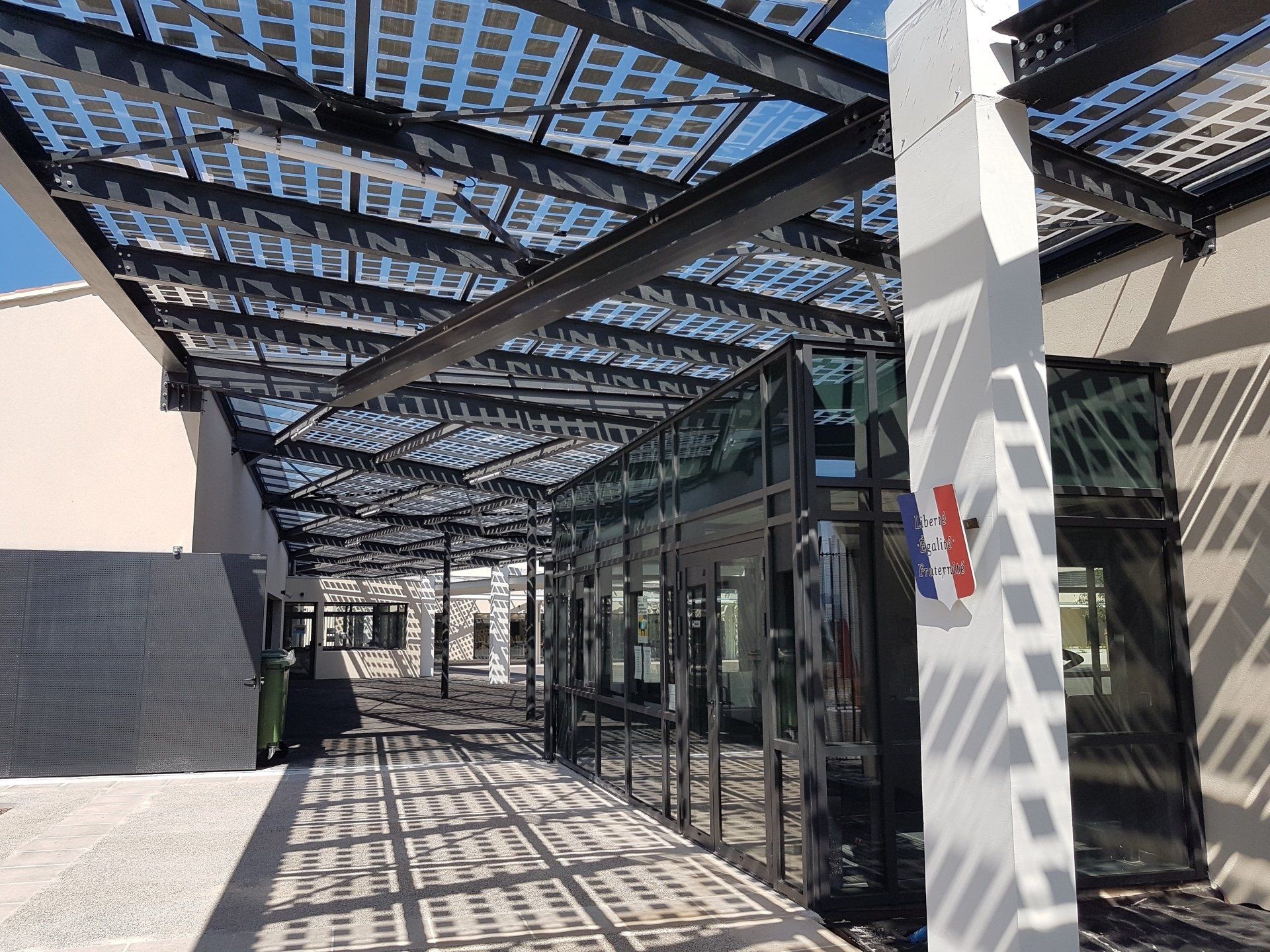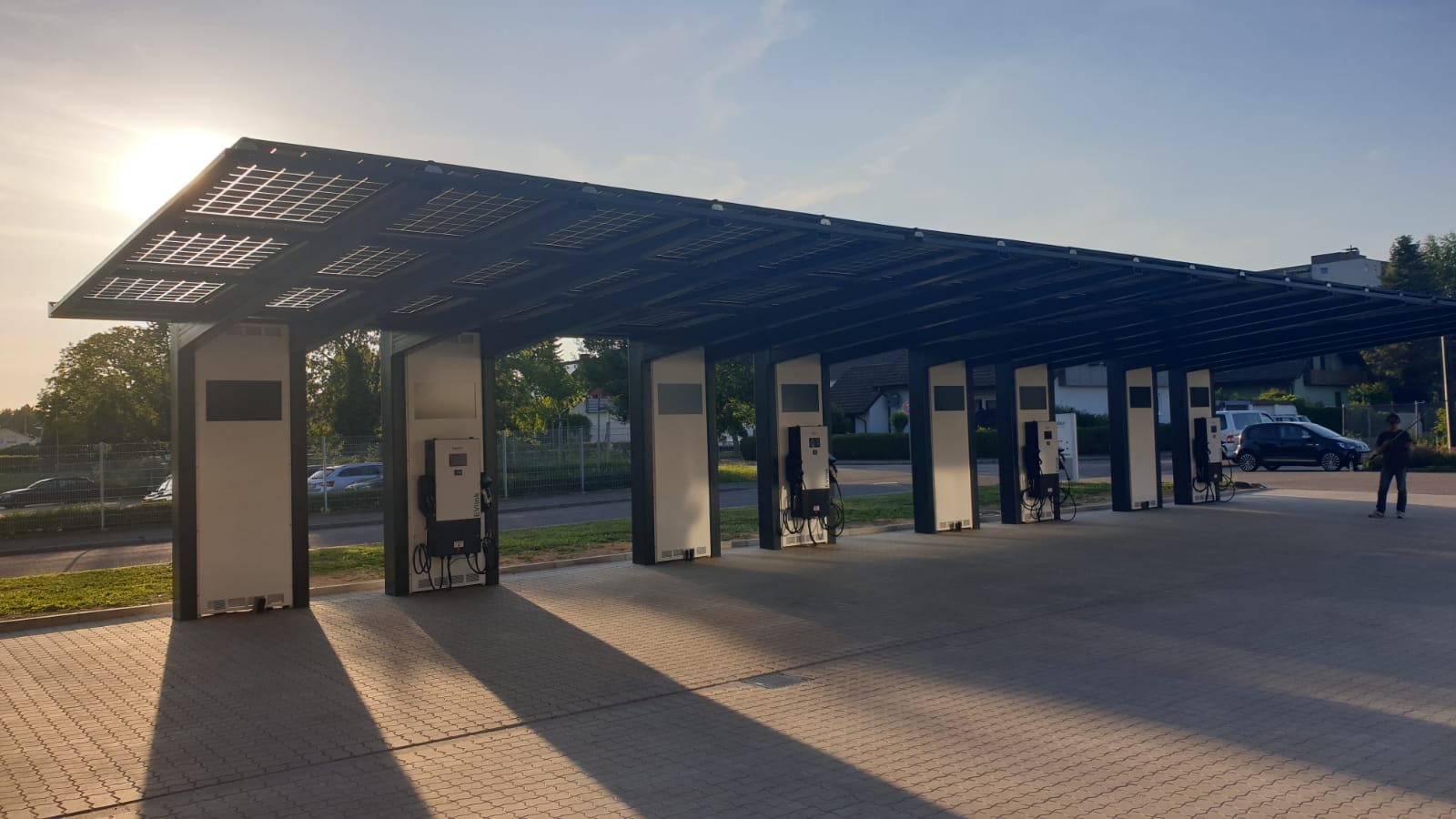Carports
Our tailor-made combination of the individual components.

What speaks in favor of covering parking lots with solar modules?
The advantages of solar-roofed parking spaces are obvious: An already sealed area can also be used to generate electricity. This means that there is no further use of space. These solar carports also offer the parked vehicles protection against excessive heating in summer and against rain, hail and snow. Depending on the type of development, the need to clear snow in winter is also reduced.
In view of the ever-increasing increase in e-mobility, solar carports can also be equipped with charging stations or wall boxes for cheap charging current: a contribution to customer loyalty and added value for visitors and employees.
With a solar power storage unit, the recommended self-consumption can be significantly increased. This storage system offers the advantage that the solar energy can still be used even when the sun is not shining and consequently no solar power is being produced. Charging an e-car in the evening or supplying other electricity consumers is no problem.
Structure of the AgriPV-Solutions Solarcarpor
Reference of the Hotel Wolfringmühle car park, in Fensterbach near Schwandorf
Constructive properties
A solar carport must be inexpensive, durable and low-maintenance. Above all, it must be possible to set up on existing parking spaces gently and easily. We attach great importance to this. In order to achieve the greatest possible electricity yield, we pay attention to the optimal alignment and inclination from the outset. It is also easier to influence with solar carports than, for example, with a given roof area.
Together with our partners, we realize a damage-free construction of the carport system on an already created parking lot. A special foundation (e.g. concrete or asphalt) is not required.
After load tests have been carried out and the soil strength has also been checked, the construction site is surveyed and the foundation points are recorded. After core drilling, the finished foundations are screwed into the ground. The support columns and cantilevers are mounted on these foundations. Trapezoidal sheets are attached to the purlins, which are then screwed on, on which in turn the (monofacial thin-film) modules are anchored.
This is followed by the installation of the AC components for connection to your own or regional power grid.
The legislator wants solar-covered parking spaces
Since January 2022 there has been a solar obligation for newly built parking spaces above a certain size in several federal states (e.g. in Baden-Württemberg, Rhineland-Palatinate, North Rhine-Westphalia, Schleswig-Holstein). At the same time, under certain conditions, the state subsidizes the construction or operation of solar carports, which can also be used for solar power systems on roofs.
Only general statements can be made here about the funding opportunities for the construction of a solar carport. Because when it comes to renewable energies, everything is currently in motion at federal and state level.
In general: The funding aspects relating to solar carports relate to the feed-in tariff and the subsidization of electricity storage, provided these are provided for in the overall concept of the system to be built. Under certain conditions, however, grants in the form of a one-off payment from the Federal Office of Economics and Export Control (KfW banking group) can also be expected.
We recommend that you find out about all funding options in the pre-planning stage of your system. You should also definitely contact your local municipal utility. Because depending on the region, corresponding carport projects are funded to a certain extent.
We would be happy to support you with your research.
Save money by using the electricity you generate yourself
At the moment, energy costs are rising sharply. It is not to be expected that electricity prices will fall for a few years either. However, there will be some relief in June 2022 due to the elimination of the EEG surcharge.
Against this background, it makes sense to use the generated green electricity yourself and thus to move in the direction of moderate electricity self-sufficiency.
There are several ways to market the generated electricity:
· Personal use
· Feeding into the network of an energy supplier
· Feeding in by way of direct marketing with the help of a provider
· Direct delivery to a nearby business bypassing the network
The following is a more detailed description of personal use:
Essentially, the price of the electricity purchased from an energy supplier consists of three cost blocks (based on the EEG 2021):
· Costs for power generation, transport and distribution
· Cost of using the networks as well
· Taxes and duties (elimination of the EEG surcharge from July 1st, 2022)
The majority of these costs are incurred for self-use (the EEG 2021 limited this self-use to a nominal output of the solar system of 30 kWp and self-consumption of 30 MWh per year).
A simplified calculation may clarify the advantages of self-consumption of self-used electricity:
Currently, the price per kWh for existing electricity supply contracts is around €0.30. In contrast, electricity can be generated with a PV system at a price of around € 0.10. Whether sales tax is to be paid on this must be determined on a case-by-case basis.
However, it is also clear that a PV system can cover between 50 and 60% of your own electricity needs in the best case, depending on the nominal output of the system and possibly with the use of electricity storage. In other words, electricity has to be purchased in off-peak periods.

















